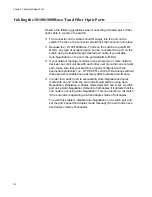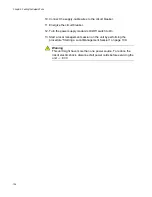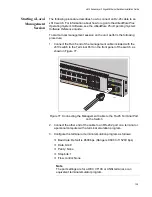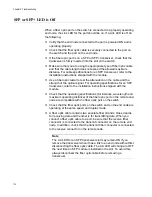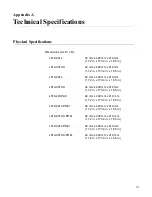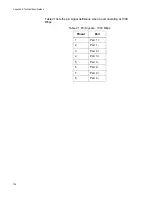
Chapter 5: Troubleshooting
116
System Fault LED is Flashing
The FAULT LED indicates several different conditions of the switch with
different flash sequences. After sequences of two or more flashes, the
LED stops briefly, then repeats the sequence. If multiple faults occur,
the LED flashes each sequence in turn, stops briefly, then repeats the
sequences. See Table 9, “System STATUS LED Descriptions” on page 43.
If the FAULT LED is flashing, the following conditions can exist:
Two Flashes
If the FAULT LED flashes two times, one or more of the fan rotors in the
chassis is operating below the recommended speed. The fan rotors can
be located in either in the chassis or in a pluggable power supply. Contact
Allied Telesis Technical Support for assistance. See “Contacting Allied
Telesis” on page 18.
Three Flashes
If the FAULT LED flashes three times, a chassis power supply fault has
occurred and the chassis is powered by AT-RPS3000 Redundant Power
Supply. Contact Allied Telesis Technical Support for assistance. See
“Contacting Allied Telesis” on page 18.
Five Flashes
If the FAULT LED flashes five times, the RPS3000 is connected to the
x610 switch, but no RPS power is available to be supplied.
Verify that the RPS3000 is receiving AC power and operating
properly. Refer to the Troubleshooting chapter in the RPS3000
Installation Guide for more information.
Six Flashes
If the FAULT LED flashes five times, stops briefly and then repeats, the
switch’s temperature has exceeded the recommended threshold.
Verify that the ambient air temperature around the x610 chassis is
in the range of 0° C to 40° C (32° F to 104° F).
Verify that the chassis inlet air vents on the front panel and the fa
exhausts on the rear panel are not blocked in a way that is
impeding airflow through the chassis.
Verify that the stacking blank panel is installed on the rear panel if
the stacking module is not installed.
Note
The Fault LED flashing one time or four times is not supported in the
design of the x610 switch.

